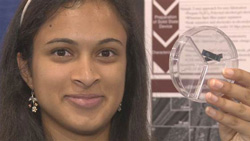California teen invents device that could charge a cell phone in 20 seconds
Daily News Article — Posted on May 28, 2013
(by John Roach, NBCNews) – Waiting hours for a cellphone to charge may become a thing of the past, thanks to an 18-year-old high-school student’s invention. She won a $50,000 prize Friday at an international science fair for creating an energy storage device that can be fully juiced in 20 to 30 seconds.
The fast-charging device is a so-called supercapacitor, a gizmo that can pack a lot of energy into a tiny space, charges quickly and holds its charge for a long time.
What’s more, it can last for 10,000 charge-recharge cycles, compared with 1,000 cycles for conventional rechargeable batteries, according to Eesha Khare of Saratoga, Calif.
“My cellphone battery always dies,” she told NBC News when asked what inspired her to work on the energy-storage technology. Supercapacitors also allowed her to focus on her interest in nanochemistry – “really working at the nanoscale to make significant advances in many different fields.”
To date, she has used the supercapacitor to power a light-emitting diode, or LED. The invention’s future is even brighter. She sees it fitting inside cellphones and the other portable electronic devices that are proliferating in today’s world, freeing people and their gadgets for a longer time from reliance on electrical outlets. [But in the future, the device could easily be used in roll-up phones or maybe even car batteries.]
“It is also flexible, so it can be used in rollup displays and clothing and fabric,” Khare added. “It has a lot of different applications and advantages over batteries in that sense.”
Khare’s invention won her the Intel Foundation Young Scientist Award at the Intel International Science and Engineering Fair, conducted this week in Phoenix, Ariz.
[“With this money I will be able to pay for my college and also work on making scientific advancements,” Khare told the audience after receiving the prize.]In announcing the winners of what it billed as the “world’s largest high school research competition,” Intel cited Khare for recognizing “the crucial need for energy-efficient storage devices” as the world rapidly adopts portable electronics.
The other winner of a Young Scientist Award with Khare was Henry Lin of Shreveport, Louisiana, who received a $50,000 prize for “simulating thousands of clusters of galaxies” to allow scientists to “better understand the mysteries of astrophysics: dark matter, dark energy and the balance of heating and cooling in the universe’s most massive objects,” the Intel statement said.
The top prize at the fair went to 19-year-old Ionut Budisteanu of Romania, who used “artificial intelligence to create a viable model for a low-cost, self-driving car,” according to an Intel statement. He received the Gordon E. Moore Award, named after the Intel co-founder, which includes a $75,000 prize.]
According to Intel, more than 1,500 young scientists from around the world were chosen to compete in last week’s fair.
Questions
- "Answers" emails have ended for the school year.
- Daily postings will end on June 7th.
- Answers emails will resume September 3rd.
NOTE TO STUDENTS: Read the "Background" and watch the video under "Resources" below the questions.
1. For what invention did California teen Eesha Khare win a $50,000 prize at the The 2013 Intel International Science and Engineering Fair?
2. What inspired Eesha to work on this invention?
3. How many teens participated in the Intel Fair?
4. For what inventions did the top place student and the other runner up win?
5. How does this article inspire you?
Background
The Intel International Science and Engineering Fair:
- The Intel International Science and Engineering Fair is the largest pre-college scientific research event in the world, and is owned and administered by the Society for Science & the Public a 501(c)(3) non-profit organization based in Washington, DC.
- Each May, more than 1500 students from roughly 70 countries and territories arrive to compete in the fair for scholarships, tuition grants, internships, scientific field trips and the grand prizes: one $75,000 and two $50,000 college scholarships.
- All prizes together amount to over $4,000,000.
- Two awards ceremonies are held including: Special Awards Organization Presentation (which now includes the Government Awards Presentations) and the Grand Awards Ceremony.
- The International Science and Engineering Fair was founded in 1950 by Science Service (now the Society for Science & the Public) and has been sponsored by the Intel Corporation since 1997.
- As of 2012, seven ISEF alumni went on to win Nobel Prizes. (from wikipedia)

